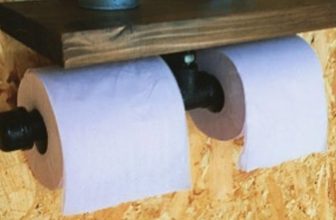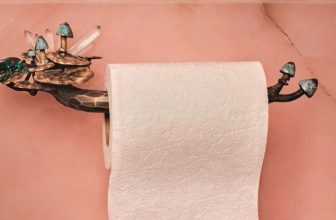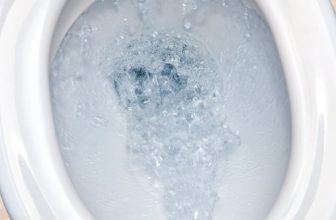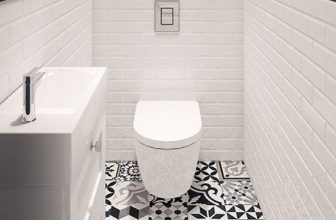How Does a Dual Flush Toilet Work?
A dual flush toilet has two flush options: a full flush for solid waste and a partial flush for liquid waste. This allows the user to conserve water by using the partial flush for most flushes.
Dual flush toilets often have a button or lever on the tank that allows the user to choose between the two flush options.
So, you’ve got a dual flush toilet – one button for a light flush, and one button for a heavy flush. But which button should you push?
Generally speaking, the light flush button should be used for liquids, and the heavy flush button should be used for solids.
Of course, there will be times when you need to use the heavy flush button for liquids (if there’s a lot of liquid, or if the liquid is particularly thick or viscous), and there will be times when you need to use the light flush button for solids (if the solid is particularly small or light).
If you’re ever unsure, err on the side of the heavy flush. It’s better to use a little more water than necessary than to have to flush a second time.
In this article, we’ll talk in detail about the dual flush toilet mechanism.
Toilet Flush Diagram
It is always nice to save water and a dual flush toilet does just that. When you push the handle down, it raises the float at the bottom of the tank and this float is connected to the seal. The seal lifts and allows water to run into the bowl until it reaches the level of the float.
When the float is exposed, it drops and the seal falls shut, stopping the flow of water. This saves quite a lot of water over traditional single-flush toilets.
Below is a diagram of a toilet flush system:
How does the Dual Flush Toilet Handles Waste?
Dual flush toilets have a larger diameter trap way that doesn’t clog as often as a conventional toilet, needs less water to flush efficiently, and saves more water than traditional toilets when flushing liquid waste.
But there are some disadvantages.
Dual flush toilets retain typically a little water in the bowl, and flushing won’t always get rid of all the waste. Full flush mode sometimes leaves streaks. With a dual-flush toilet, you will probably use the toilet brush more often.
Installing a Dual Flush Toilet
Installing a dual flush toilet is not a difficult task, but there are a few things to consider before getting started. The most important thing to keep in mind is the rough-in measurement, which is the distance from the wall behind the toilet to the center of the bolts attaching the toilet to the floor.
Depending on the model of toilet you choose, the instructions for installation may vary slightly.
General steps to install a dual flush toilet:
- Turn off the water supply to the toilet and flush the toilet several times to remove any water from the bowl and tank. Use a shop vacuum to remove any water that remains.
- Next, disconnect the toilet’s supply hose from the water supply line. Then, disconnect the tank from the bowl by removing the two bolts that attach it in place. You may need a helper to lift the tank off of the bowl.
- With the tank removed, unscrew the two bolts that attach the old toilet to the floor. You can now lift the old toilet out of your home.
- To install the new toilet, first, attach the wax seal or gasket to the bottom of the bowl according to the manufacturer’s instructions. Next, attach the offset collar or adapter to the closet flange (the fitting that connects to the drain line). Place the new toilet in position and install any necessary bolts.
- Install the rubber gasket on the outlet of the water tank. Insert the bolts and rubber nuts. Attach the tank to the bowl by threading the bolts through the holes in the back of the bowl. Add the nuts and tighten them.
- Reconnect the supply hose to the water supply line. Some toilet installation kits include a new hose.
- Apply a silicone seal around the base of the toilet.
- Finally, reconnect the water line and install the toilet seat.
Why Won’t Your Dual Flush Toilet Stop Running?
If your dual flush toilet keeps running, there are a few things that could be causing the issue. The most common cause is a faulty damper. The flap is the rubber seal that covers the opening at the bottom of the tank. When you flush the toilet, the flap rises and the water flows out of the tank into the bowl.
If the flapper is not sealing properly, water will continue to leak into the bowl, causing the toilet to keep running.
Another possible cause of a running dual flush toilet is a problem with the fill valve. The fill valve is responsible for supplying water to the tank after each flush. If the fill valve is not working properly, water will continue to drip into the tank, causing the toilet to run.
If you have checked the flapper and fill valve and both appear to be working properly, the next step is to check the push button flush valve. The flush valve is located at the top of the tank and is responsible for releasing water into the bowl when you flush the toilet.
If the dual flush toilet fill valve is not working properly, water will not be released into the bowl and the toilet will keep running.
If you have checked all of the above and the toilet still keeps running, it is likely that there is a problem with the float. A float is a floaty object that sits on top of the water in the tank. Its purpose is to tell the fill valve when to turn off the water.
If the float is not positioned properly, the fill valve will not turn off and water will continue to flow into the tank, causing the toilet to keep running.
Advantages of Using a Dual Flush Toilet
There are many benefits that come with using a dual flush toilet.
For starters, they are more water-efficient than traditional toilets. This is because they have two flush options – a full flush for solid waste and a half flush for liquid waste. This means that you can save a lot of water over time, which is good for the environment and your wallet.
Another advantage of dual flush toilets is that they tend to be more hygienic. This is because the half flush option ensures that any liquid waste is quickly flushed away, leaving the bowl clean and free of bacteria.
Finally, dual flush toilets tend to be more comfortable to use. This is because the half flush option allows you to go without making too much noise or splashing water around.
FAQ
What happens if you press both buttons on a dual-flush toilet?
Pushing both buttons on a dual flush toilet will result in the same amount of water being released as if you had only pushed the larger button. This is because the dual flush toilet is designed to release a maximum of six liters of water when both buttons are pressed, which is the same amount of water that is released when the larger button is pressed.
Do dual flush toilets have more problems?
One problem is that the buttons or levers are often too close together, which can cause users to accidentally flush with the wrong amount of water. This can lead to clogs or overflows. Additionally, the valves and gaskets in dual flush toilets are often of lower quality, which can also lead to leaks and other problems.
Do dual-flush toilets leak?
Dual-flush toilets may be more prone to leakage than single-flush toilets. The drop valve system, which is used by many dual-flush toilets, allows water to flow out when the flush is pressed. This design may make it more likely for water to leak from the toilet.
Why are dual flush toilets better?
Dual flush toilets are a more efficient way to flush waste because they use less water. They have two buttons, one for a light flush and one for a full flush. This allows you to use less water when flushing waste that is not solid.
Bottom Line
A dual flush toilet has two flush settings: a full flush for liquid waste and a reduced flush for solid waste. The full flush uses more water than the reduced flush, but both settings use less water than a traditional toilet.
Dual flush toilets are more water-efficient than traditional toilets, and they can help save water and money over time.
Do you have any experience with using a dual flush toilet? Share it in the comments.



